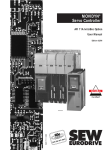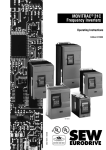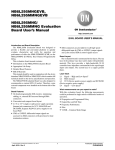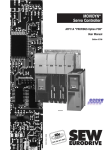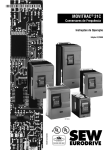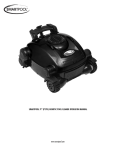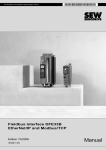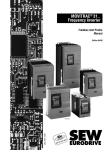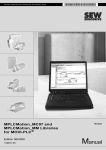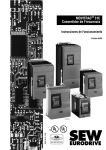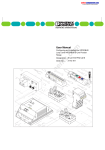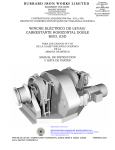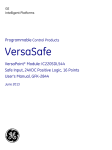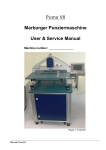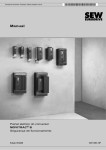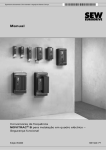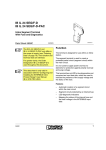Download MOVITRAC® 31.. FFI31 INTERBUS Interface - SEW
Transcript
T MOVITRAC® 31.. Frequency Inverters INTERBUS Fieldbus Interface (FFI31.. option and size 0/INTERBUS) Manual Edition 1/99 08/198/96 0922 6915 / 199 C UL ® UL ® Important Notes Important Notes • Read this user manual carefully before you start installation and commissioning work on MOVITRAC® frequency inverters with fieldbus options. This user manual assumes that the user is familiar with and has at his disposal all relevant documentation on the MOVITRAC® system, particularly the installation and operating instructions. • Safety notes: Always follow the safety notes contained in this user manual. Safety notes are marked as follows: Electrical hazard, e.g. during live working Mechanical hazard, e.g. when working on hoists. Important instructions for the safe and fault-free operation of the system, e.g. presetting before commissioning.Failure to follow these instructions may result in injury to people and damage to property. 2 • General safety notes for bus systems: The fieldbus option gives you a communications system which allows you to match the MOVITRAC® 31.. drive system to the specifics of your application to a very high degree. As with all bus systems there is, however, the risk of parameters being changed, which will not show outside (i.e. the inverter) but affect the behaviour of the inverter. This may result in unexpected (not uncontrolled, though) system behaviour. • In these instructions, cross-references are marked with an →, e.g., (→ MC_SHELL) means: Please refer to the MC_SHELL User Manual for detailed information or information on how to carry out this instruction. (→ section x.x) means: Further information can be found in section x.x of this user manual. • Each unit is manufactured and tested to current SEW-EURODRIVE technical standards and specifications. The manufacturer reserves the right to make changes to the technical data and designs as well as the user interface herein described, which are in the interest of technical progress. A requirement for fault-free operation and fulfilment of any rights to claim under guarantee is that these instructions and notes are followed. These instructions contain important information for servicing, they should therefore be kept near the unit. MOVITRAC® 31.. INTERBUS Fieldbus Interface Contents Page 1 Introduction ..............................................................................................4 2 Assembly / Installation Instructions .................................................................6 2.1 Fitting the FFI31.. interface...............................................................................................6 2.1.1 Scope of Delivery................................................................................................... 6 2.1.2 Supported Inverter Types ...................................................................................... 6 2.1.3 Fitting the Interface PCB ........................................................................................ 6 2.2 Installing the MOVITRAC® 31.. size 0 with INTERBUS ...................................................... 7 2.3 Pin Assignment................................................................................................................ 8 2.4 Screening and Laying of the Bus Cables .......................................................................... 9 2.5 Setting the Process Data Length...................................................................................... 9 2.6 Display Elements ........................................................................................................... 10 3 Configuring and Commissioning ................................................................... 11 3.1 Inverter Control Mode ‘Fieldbus’.................................................................................... 11 3.2 Parameter P801 “Save” ................................................................................................. 12 3.3 Bus Topologies with MOVITRAC® 31.. .......................................................................... 13 3.3.1 Direct Connection to DCB Master Modules.......................................................... 13 3.3.2 Direct Connection to DAB Master Modules.......................................................... 14 3.3.3 Integration in 8-Wire Remote Bus Systems......................................................... 14 3.4 Inverter Module Identity................................................................................................. 15 3.5 Configuring the Master Module ..................................................................................... 15 3.5.1 Configuring for 1 Process Data Word.................................................................. 16 3.5.2 Configuring for 2 Process Data Words ................................................................ 17 3.5.3 Configuring for 3 Process Data Words ................................................................ 18 4 The PMS Interface .................................................................................... 19 4.1 PMS Services ................................................................................................................19 4.1.1 Initiate ................................................................................................................. 19 4.1.2 Abort ................................................................................................................... 20 4.1.3 Reject .................................................................................................................. 20 4.1.4 Identify ................................................................................................................ 20 4.1.5 Get-0V ................................................................................................................. 20 4.1.6 Status .................................................................................................................. 20 4.1.7 Read .................................................................................................................... 20 4.1.8 Write.................................................................................................................... 20 4.2 Object List...................................................................................................................... 21 4.2.1 Object Description of the Drive Parameters........................................................ 21 4.2.2 “Download Parameter Block” Object ................................................................... 22 4.2.3 “Universal Write Parameter” Object..................................................................... 23 4.2.4 “Universal Read” Functionality Objects................................................................ 24 5 Parameter Adjustment Return Codes .............................................................. 27 5.1 Internal Communications Error...................................................................................... 27 6 Technical Data ........................................................................................ 28 6.1 FFI31.. Interface Technical Data ..................................................................................... 28 6.2 Technical Data MOVITRAC® 31.. BG0/INTERBUS............................................................ 29 Appendix A ............................................................................................. 30 Index .................................................................................................... 31 MOVITRAC® 31.. INTERBUS Fieldbus Interface 3 1 Introduction 1 Introduction This FFI 31.. INTERBUS Interface Manual describes the procedure for installing the FFI 31C INTERBUS Interface in the inverter and for commissioning the MOVITRAC® 31.. size 0 inverter with integrated INTERBUS interface when connected to an INTERBUS fieldbus system. In addition to describing all the settings on the fieldbus interface, this manual further discusses the various options for connecting the inverter to INTERBUS in the form of brief commissioning examples. In addition to this INTERBUS Interface Manual, you should order the following more detailed documentation on the INTERBUS fieldbus interface in order to connect the MOVITRAC® 31.. simply and efficiently to the INTERBUS fieldbus system • MOVITRAC® 31.. Fieldbus Unit Profile Manual (Order no. 0922 7016) • MOVITRAC® 31.. Communications Interfaces and Parameter List (Order no. 0923 0580) The MOVITRAC® 31.. Fieldbus Unit Profile Manual gives a detailed description of the fieldbus parameters and their codings and discusses various control concepts and application options in the form of brief commissioning examples. The MOVITRAC® 31.. Parameter List contains a list of all the inverter’s parameters that can be read or written via the various communication interfaces such as the RS-232, RS-483 and via the fieldbus interface. The MC_Shell software makes it straight forward and easy to operate the inverter and set the parameters, including the parameters for the fieldbus. This software can be ordered from SEW under the number 0921 2949. MOVITRAC® 31.. and INTERBUS The inverter unit profile for INTERBUS mode, i.e. the way the inverter operates and responds when in INTERBUS mode, is independent of the type of fieldbus, and thus consistent for all fieldbus types. This allows the user to develop his drive applications independent of a particular fieldbus or change to another bus system, e.g. the open standardized PROFIBUS-DP/FMS (FFP 31C option) fieldbus system. MOVITRAC® 31.. offers digital access to all drive parameters and functions via the INTERBUS Interface. The inverter is controlled by the high-speed cyclic process data. This process data channel provides the facility to specify setpoints such as setpoint speeds, ramp generator times for acceleration and deceleration etc., as well as various drive functions such as enable, controller inhibit, stop, rapid stop, etc. to be triggered. This channel can also be used to read back actual values from the inverter, such as actual speed, current, unit status, error number or reference messages. Whereas process data are generally exchanged in cycles, the drive parameters can only be read and written acyclically via the READ and WRITE services. This exchange of parameter data enables applications where all major drive parameters are stored in the higher-level automation unit to be implemented, thus avoiding manual adjustment of parameters on the inverter itself, which can often be very time-consuming. 4 MOVITRAC® 31.. INTERBUS Fieldbus Interface Introduction 1 Controller INTERBUS Master Frequency inverter E 84 1 F E L DB U S S T EU ER M OD E SE W EU RO DR IVE Q E 8 41 F E L D BU S ST E U ER M O D E SE W EU RO DRIV E Q E MOVITRAC F E LD B U S ST E U ER M O D E EU RO DRIV E MOVITRAC MOVITRAC 8 41 SE W INTERBUS-S Module Ident. 227 841 Fieldbus CONTROL MODE Q E P SEW SEW SEW E U RO D R I VE E U R OD R IV E E U R OD R I VE P P P Q P INTERBUS Input/output modules INT ER BU S Fig. 1: INTERBUS with MOVITRAC® 31.. 00469AEN The INTERBUS Interface option pcb is designed so that all INTERBUS specific settings, such as the process data length, can be made on the interface by means of a hardware switch. These manual settings enable the inverter to be integrated into the INTERBUS system and switched on in a very short space of time. Parameters can be set fully automatically by the higher-level INTERBUS master (parameter download). This forward-looking version offers the benefits of a shorter commissioning period for the plant as well as simpler documentation of the application program, as all major drive parameter data can now be recorded directly in the control program. The use of a fieldbus system in drive technology requires additional monitoring functions, such as fieldbus timeout or special emergency stop concepts. The monitoring functions of the MOVITRAC ® 31.. can be matched to the specific application for which it is to be used. This feature enables you, for instance, to specify which error response the inverter should trigger if an error should occur in the bus. A rapid stop will be practical for many applications, but it is also possible to freeze the last setpoints, so that the drive can continue with the last valid setpoints (e.g. conveyor belt). As the functionality of the control terminals is also ensured when the inverter is operated in the fieldbus mode, fieldbus-independent emergency stop concepts can still be implemented via the inverter’s terminals. The MOVITRAC® 31.. inverter offers numerous diagnostic facilities for commissioning and servicing. For instance, both the setpoints transmitted from the higher-level control unit as well as the actual values can be checked with the fieldbus monitor in the hand-held keypad. It also provides you with a lot of additional information on the status of the fieldbus option pcb. The PC software MC_SHELL offers even more convenient diagnostic facilities in that it provides a detailed display of the fieldbus and unit status information as well as the facility to set all the drive parameters (including the fieldbus parameters). MOVITRAC® 31.. INTERBUS Fieldbus Interface 5 2 Assembly / Installation Instructions 2 Assembly / Installation Instructions The following section describes assembly and installation of the MOVITRAC® 31.. inverter for integration in an Interbus system. Sizes 1...4 of the MOVITRAC® 31.. inverter are connected to the INTERBUS via the FFI31 interface. The standard basic unit of the MOVITRAC® 31.. Size 0 contains an integrated Interbus interface. To set the fieldbus parameters you will need the FBG31.. keypad for MOVITRAC® 31.. and/or the latest version of the MC_SHELL software. 2.1 Fitting the FFI31.. interface This option is either delivered separately, so that you will have to install it yourself, or you can order an inverter which comes complete with the FFI31 interface installed. 2.1.1 Scope of Delivery The FFI31 interface comprises the following components: – 1 FFI31C (INTERBUS) interface pcb – 3 fastening screws – 1 housing cover – earthing clamp for the outgoing remote bus Please check to see that delivery is complete. 2.1.2 Supported Inverter Types The FFI31.. interface for connection to an INTERBUS system can be operated with the MOVITRAC® 31 inverters sizes 1...4 as follows: FFI31A interface: for MOVITRAC® 31B inverters when the service code of the size 4 group is greater than or equal to 14 (→ Assembly and Installation of MOVITRAC® 31B, Sec. 4). FFI31C interface: for all MOVITRAC®31C inverters, sizes 1...4. 2.1.3 Fitting the Interface PCB Before you begin: • Before touching the pcb discharge yourself with the appropriate measures (earthing band, conductive shoes, etc.) • Store the pcb in the original package and only unpack immediately before installation. • Do not touch the pcb more often than necessary and hold only by the edges. Do not touch components. Installation of the pcb: • Disconnect inverter from the supply. Switch off mains supply and, if applicable, the 24 V supply. • Take off the lower protective cover. • Unscrew and remove the housing (screw located under the cover for the keypad). • Unscrew the EPROM pcb and remove it from the X20 connector. • Push the FFI31.. pcb into the X20 connector and fasten with the screws. • Take the fitted cover out of the housing and replace it with the cover delivered with the option. • Replace the housing and fasten with the screws. • Replace the lower protective cover. The FFI31.. is now completely fitted. 6 MOVITRAC® 31.. INTERBUS Fieldbus Interface Assembly / Installation Instructions 2 ® MOVITRAC processor pcb EPROM Process data length DPRAM Flash EPROM Processor X20: Supi X9: LED green: UL LED green: RC LED green: BA LED green: TR LED red: RD X10: S1 X2: X3: Two-wire Two-wire remote bus input remote bus output 00305AEN Fig. 2: FFI31.. option 2.2 Installing the MOVITRAC® 31.. size 0 with INTERBUS Size 0 inverters (MOVITRAC® 31.. Size 0 with INTERBUS) have the INTERBUS interface already installed as a standard in the basic unit (→ Fig. 3). 1 DIP switch for setting the process data length. 2 Five LEDs for diagnosis of the INTERBUS system. 1 3 9-pin sub-D connector, male (input for remote bus). 2 4 9-pin sub-D connector, female, (output for remote bus). 3 4 02125AXX Fig. 3: MOVITRAC ® Inverter with INTERBUS interface and the FBG31 keypad. MOVITRAC® 31.. INTERBUS Fieldbus Interface 7 2 Assembly / Installation Instructions 2.3 Pin Assignment The MOVITRAC® 31.. inverter is connected to the INTERBUS system via the 2-wire remote bus by a 6-core screened cable with twisted-pair signal leads. The 2-wire remote bus basically consists of an RS-485 Data Out channel (signal lines DO and DO) as well as of the RS-485 Data In channel (signal lines DI and DI). There is a 9-pin sub-D connector (male) for the remote bus output and a 9-pin sub-D connector (female) for the remote bus input on the inverter itself. The incoming remote bus cable must have a female 9-pin sub-D connector and the outgoing remote bus cable must have a male 9-pin sub-D connector. Incoming remote bus on the remote bus input. 9-pin sub-D connector (female) Twisted-pair signal cables DO DO DI DI COM 1 2 3 4 5 6 1 7 2 3 6 7 8 9 Green Yellow Pink Grey Brown Conductive connection between connector housing and screen. 02092AEN Fig. 4: Assignment of the 9-pin sub-D connector of the incoming remote bus cable Outgoing remote bus on the remote bus output. 9-pin sub-D connector (male) Twistet -pair signal cables 1 6 2 7 8 3 9 4 5 DO DO DI DI COM 6 1 7 2 3 5 9 Green Yellow Pink Grey Brown Bridged Conductive connection between connector housing, cable shield. 02093AEN Fig. 5: Assignment of the 9-pin sub-D connector of the outgoing remote bus cable 8 MOVITRAC® 31.. INTERBUS Fieldbus Interface Assembly / Installation Instructions 2.4 2 Screening and Laying of the Bus Cables The INTERBUS Interface supports RS-485 transmission technology and requires as a physical medium the 6-core, screened, two-wire twisted-pair cable specified for INTERBUS. Technically correct screening of the bus cable absorbs the electrical interference that can occur in an industrial environment. You will achieve the best screening results if you adopt the following measures: • Hand-tighten the fixing screws of plugs, modules and equipotential bonding conductors • Only use plugs with metal or metal-plated housings • Connect the screening in the plug over as large an area as possible • Connect the screening at both ends of the bus cable • Do not lay signal and bus cables parallel to power cables (motor leads), but wherever possible in separate cable conduits • In an industrial environment use metallic, earthed cable trays • Run signal cables and the associated equipotential bonding conductor as close as possible to each other, using the shortest route • Avoid extending bus cables through the use of connectors • Run the bus cables close to existing earthed surfaces IMPORTANT! In the event of fluctuations in the earth potential, a circulating current may flow through any screening which may be connected at both ends and connected to the earth potential (PE). In this case, ensure there is adequate equipotential bonding in accordance with the relevant safety provisions. In the event of further questions regarding the installation of the bus system, refer to the INTERBUS installation manual IBS SYS INST UM (Order No. 2754286, PHOENIX CONTACT), from which the points mentioned above were also taken. 2.5 Setting the Process Data Length The MOVITRAC®31.. inverter communicates via INTERBUS with the higher-level control both via the rapid cyclical process data channel and via the acyclical parameter channel (PCP, Peripherals Communication Protocol). The number of process data words to be transmitted in the process data channel is variable and can be adjusted using the DIP switches on the INTERBUS Interface. In general you have a choice between one, two and three process data words. In all three cases, the inverter can be parameterized at any time via the PCP channel. ON 1 OPEN 2 3 4 S1 S2 S3 S4 S1 S2 OFF OFF -OFF ON 1PD ON OFF 2PD Setting as supplied: 2PD ON ON 3PD 00308AEN Fig. 6: Setting the process data length in process data words MOVITRAC® 31.. INTERBUS Fieldbus Interface 9 2 Assembly / Installation Instructions An example of the DIP switch settings for all three data process lengths is shown in Fig. 7 below. Switches S3 and S4 are not allocated. These DIP switches are only evaluated when the inverter is started up, i.e. when power is connected (mains and external 24 V supply). This means that the inverter has to be switched on again when the process data length is changed (mains and 24 V). ON OPEN S1 S2 S3 S4 2 3 4 Setting: 2 process data words ON 1 OPEN 2 3 4 OPEN 2 3 4 Setting: 1 process data word 1 S1 S2 S3 S4 1 S1 S2 S3 S4 ON Setting: 3 process data words 00309AEN Fig. 7: Example for setting the process data length 2.6 Display Elements The FFI 31C.. interface has five LEDs for diagnosing the INTERBUS system. These LEDs provide information about the status of the INTERBUS system. The meaning of each LED is shown in Table 1. LED Name Colour Status Meaning UL (green) RC (green) BA TR RD green green green green red on on on on / flickering on Logic voltage FFI 31 C interface Incoming remote bus ready for operation (remote bus link o.k.) Bus in operation Parameter data exchange via PCP channel Onward remote bus off Table 1: Meaning of the diagnostic LEDs for INTERBUS Order of LEDs in the MOVITRAC® 31.. sizes 1...4 UL RC BA TR RD the MOVITRAC® 31.. size 0 INTERBUS-S Module Ident. 227 UL RC BA TR RD 00310BXX Fig. 8: Display elements 10 MOVITRAC® 31.. INTERBUS Fieldbus Interface Configuring and Commissioning 3 3 Configuring and Commissioning This section shows you how to configure and commission the MOVITRAC® 31.. inverter with the INTERBUS interface in the INTERBUS master module. 3.1 Inverter Control Mode ‘Fieldbus’ After installing the INTERBUS interface and setting the process data length (using the DIP switches), the MOVITRAC® 31.. inverter parameters can be set immediately via the fieldbus system without any further manual intervention. This means, for example, that after switching on the inverter, all drive parameters can be downloaded directly from the higher-level control via the INTERBUS system. To control the inverter via INTERBUS, however, it must first be switched to the appropriate control mode. This is possible using the parameter P841 Control Mode. The factory setting for this parameter is STANDARD (control and setpoint processing via input terminals). Using the parameter P841 Control Mode = FIELDBUS, the inverter is programmed to accept setpoints from the fieldbus. MOVITRAC® 31.. now responds to process data sent from the higher-level control. The activation of fieldbus control mode is signalled to the higher-level control by the Fieldbus Mode Active bit in the status word. For safety reasons, the inverter must also be enabled on the terminal side as well to permit control via the fieldbus system. The terminals are therefore to be wired or programmed in such a way that the inverter is enabled via the input terminals. The easiest way of enabling the inverter on the terminal side is, for example, to connect input terminal 41 (CW/STOP function) to a +24 V signal and program input terminals 42 and 43 to NO FUNCTION. Fig. 9 shows an example of the commissioning procedure for the MOVITRAC® 31.. inverter with a fieldbus interface. Important! The inverter must be disconnected from the mains supply during commissioning. Commissioning must be carried out only with the 24 V supply. This ensures that the drive will not start up unintentionally during reprogramming. Only turn the mains supply on when all the parameters have been set. MOVITRAC® 31.. INTERBUS Fieldbus Interface 11 3 Configuring and Commissioning 1. ENABLE the inverter on the terminal side Use this jumper to enable the inverter via terminal side +24 V 1/0 CW/STOP no function no function X3 X2 Size 1 - 4 X3 X14 31 34 35 0 65 40 44 41 42 43 47 60 30 61 62 48 49 60 30 no function no function Size 0 31 34 35 0 65 40 44 41 42 43 47 60 30 61 62 48 49 X2 +24 V 1/0 CW/STOP Apply a +24 V signal on input terminal 41 (Function CW/STOP) (e.g. set jumper as shown below). Jumper installed when supplied Use this jumper to enable the inverter via terminal side Jumper installed when supplied 2. For setting inverter parameter only switch on 24 V supply (no mains voltage!) 3. Control mode = fieldbus Set control and setpoint processing of the drive inverter to FIELDBUS in parameter P841. 841 FIELDBUS CONTROL MODE 4. Input terminal 42 = NO FUNCTION: Program functionality of input terminal 42 to NO FUNCTION in parameter P600. 600 NO FUNCT. TERMINAL 42 5. Input terminal 43 = NO FUNCTION: Program functionality of input terminal 43 to NO FUNCTION in parameter P601. 601 NO FUNCT. TERMINAL 43 00312BEN Fig. 9: Activating the FIELDBUS control mode For further information on commissioning and controlling the MOVITRAC® 31.. inverter, please refer to the Fieldbus Unit Profile manual, available from SEW under the number 0922 7016. 3.2 Parameter P801 “Save” The service life of an EEPROM (parameter memory) is limited by the number of save operations carried out on it. In fieldbus operations with “acyclical writing of Parameters”, the parameter values are changed frequently. In this case it is necessary to set Parameter P801 to “Save” = “OFF” when commissioning has been completed. 12 MOVITRAC® 31.. INTERBUS Fieldbus Interface Configuring and Commissioning 3.3 3 Bus Topologies with MOVITRAC® 31.. The INTERBUS interface enables the MOVITRAC® 31.. inverter to be integrated directly into the INTERBUS 2-wire remote bus. This results in much easier installation of the inverter in the switch cabinet, because, as the maximum remote bus length is 400 metres, the drives can also be installed further apart from each other without any difficulty. As a result, the connecting costs are significantly reduced in comparison with an INTERBUS local bus interface, since no bus terminals are required any more for connecting the inverters. For historical reasons, the INTERBUS sensor/actuator bus distinguishes between two types of remote buses, both of which still exist today: the 8-wire and the 2-wire remote bus. The essential difference between the (older) 8-wire remote bus and the newer 2-wire remote bus is in the number of signal lines in the remote bus cable. Whereas there was a relatively large amount of wiring work required in preparing the 8-wire remote bus cable with its 25-pin connectors, 9-pin sub-D connectors can now be used with the 2-wire remote bus. With only 5 signal lines, these connectors can be quickly fitted to the remote bus cable. The IBS BK LC/2 bus terminal was developed to ensure as simple a transition as possible between these two types of remote bus. This terminal provides a simple and user-friendly way of converting from one type of remote bus to the other. Different INTERBUS topologies involving MOVITRAC® 31.. are shown below as examples in which both types of remote bus are used. 3.3.1 Direct Connection to DCB Master Modules The second generation INTERBUS master modules, such as the IBS S5 DCB module for Simatic S5, are always equipped with the 2-wire remote bus. Thus the inverter can be connected directly to the DCB master module as shown in Fig. 10. . 0140 -- INTERBUS master module with 2-wire remote bus, e.g. IBS S5 DCB E Q 84 1 F E L DB U S S T EU ER M OD E SE W EU RO DR IVE E Q 8 41 F E L D BU S ST E U ER M O D E SE W EU RO DRIV E E Q SEW SEW SEW E U RO D R I VE E U R OD R IV E E U R OD R I VE 2-wire remote bus (max. 400 m) MOVITRAC EU RO DRIV E MOVITRAC F E LD B U S ST E U ER M O D E SE W MOVITRAC 8 41 2-wire remote bus (max. 400 m) 2-wire remote bus (max. 400 m) 00470AEN Fig. 10: Direct connection of the inverter to DCB modules with 2-wire remote bus Since these DCB master modules generally support up to 256 remote bus stations, they are superbly suited for high-performance drive applications with many inverters. MOVITRAC® 31.. INTERBUS Fieldbus Interface 13 3 Configuring and Commissioning 3.3.2 Direct Connection to DAB Master Modules First generation INTERBUS diagnostics interfaces (DAB), e.g. the IBS S5 DAB module for Simatic S5, only support the old 8-wire fieldbus and 25-pin sub-D connector. MOVITRAC® 31.. inverters are connected by using an IBS BK LC/2 bus terminal. This bus terminal makes possible the conversion from the old 8-wire remote bus to the new 2-wire system. Fig. 11 shows the connection of the MOVITRAC® 31.. to the DAB modules. A standard cable for the 8-wire remote bus is employed from the DAB master module to the bus terminal. The connection from the bus terminal to the inverter is achieved by an adapter cable from 25-pin sub-D to 9-pin sub-D. 01 4 0 -- INTERBUS master module with 8-wire remote bus e.g. IBS S5 DAB Bus terminal IBS BK LC/2 8-wire remote bus (max. 400 m) IBS BK LC/2 E 84 1 F E L DB U S S T EU ER M OD E SE W EU RO DR IVE Q E 8 41 MOVITRAC F E LD B U S ST E U ER M O D E EU RO DRIV E MOVITRAC 8 41 SE W MOVITRAC P F E L D BU S ST E U ER M O D E SE W EU RO DRIV E Q E Q SEW SEW SEW E U RO D R I VE E U R OD R IV E E U R OD R I VE 2-wire remote bus (max. 400 m) 2-wire remote bus (max. 400 m) 2-wire remote bus (max. 400 m) 00471AEN Fig. 11: Connection of the inverter to DAB master modules via IBS BK LC/2 bus terminal 3.3.3 Integration in 8-Wire Remote Bus Systems Conversion from both the 8-wire to the 2-wire remote bus, as well as from the 2-wire to the 8-wire remote bus, is achieved using the IBS BK LC/2 bus terminal. This means, for example, that MOVITRAC® 31.. inverters can also be integrated into existing INTERBUS networks employing the old 8-wire remote bus. Fig. 12 shows the integration options in an already existing system with an 8-wire remote bus. Bus terminal IBS BK LC/2 F E LD B U S ST E U ER M O D E EU RO DRIV E IBS BK LC/2 E 8-wire remote bus 2-wire remote bus 84 1 F E L DB U S S T EU ER M OD E SE W EU RO DR IVE Q E Q 8 41 F E L D BU S ST E U ER M O D E SE W EU RO DRIV E E Q SEW SEW SEW E U RO D R I VE E U R OD R IV E E U R OD R I VE 2-wire remote bus 2-wire remote bus MOVITRAC 8 41 SE W MOVITRAC P MOVITRAC Incoming 8-wire remote bus Bus terminal IBS BK LC/2 P IBS BK LC/2 2-wire remote bus 8-wire remote bus Onward 8-wire remote bus Fig. 12: Integrating MOVITRAC® 31.. inverters in already existing 8-wire remote bus systems 14 00472AEN MOVITRAC® 31.. INTERBUS Fieldbus Interface Configuring and Commissioning 3 MOVITRAC® 31.. inverters can be integrated into the existing 8-wire remote bus system at any point by splitting the 8-wire remote bus. This is done by feeding the incoming 8-wire remote bus to an IBS BK LC/2 bus terminal. Using an appropriate adapter cable, you can now connect the first MOVITRAC® 31.. inverter to the bus terminal and network all the other inverters using the standard 2-wire remote bus cable. A further IBS BK LC/2 bus terminal must then be connected following the last inverter. This handles the conversion back to the 8-wire remote bus. Both the local bus interfaces of the newly inserted bus terminals can naturally also be used. When extending an already existing INTERBUS 8-wire remote bus system, bear in mind that master modules with 8-wire remote bus interfaces generally support only 64 remote bus subscribers. More detailed information can be found in the master module documentation. 3.4 Inverter Module Identity With the INTERBUS interface MOVITRAC® 31.. is assigned the following identity code. Module Ident: 227dec = E3hex You must enter this identity code into the configuration list of the INTERBUS master module. 3.5 Configuring the Master Module To initialise the INTERBUS master module, you must draw up various lists containing all the modules connected to the INTERBUS. These lists are made up of the following entries. • Process data width with module ident code • Peripheral bus address • Input address • Output address • Group number (optional) • Communication reference (optional) The modules are shown in the configuration list in the order corresponding to their physical position in the INTERBUS. During the initialisation of the bus system, the master module checks the planned bus configuration against the INTERBUS configuration read-in. If these configurations are different, the bus system will not start. This situation is indicated by an appropriate error message on the master module. There are three initialisation options for a MOVITRAC® 31.. inverter with the INTERBUS interface. Which option is used depends on the process data length selected. While configuring, bear in mind that process data length 3 provides the most powerful application potential for the MOVITRAC® 31.. inverter with INTERBUS. As a consequence of the direct insertion of process data into the I/O and/or peripherals area of the control, you should generally select process data length 3 if your application concept is not yet complete and if you do not definitely know with which process data length the inverter is to be controlled. MOVITRAC® 31.. INTERBUS Fieldbus Interface 15 3 Configuring and Commissioning 3.5.1 Configuring for 1 Process Data Word Setting the DIP switches on the option pcb to give process data length 1 requires that 1 process data word is specified in the ID code list. Fig. 13 shows examples of entries in the ID code list. ON 1 ID code list: Process data width: 1 (word) Module Ident: 227 OPEN 2 3 4 Example for S5 data module: DW n: KY = 001, 227 MC31.. : 1 PD, ID227 Setting: 1 process data word 00473AEN Fig. 13: Example of ID code list with process data length set at 1 INTERBUS master modules for programmable controllers (e.g. IBS S5 DAB/DCB for Simatic S5) map the process data to the I/O and/or peripheral area of the control. You must therefore specify the start addresses for the input and output data in the I/O address list of the INTERBUS master module. Fig. 14 shows an example of how the process data word transferred via INTERBUS is mapped in the control. PLC adress area ® Output adress for MOVITRAC 31.. : PW 140 T PW 140 PW 140 PD 1 EU RO DRIV E E PD 1 L PW 140 PW 140 F E L D BU S ST E U ER M O D E SE W MOVITRAC 8 41 PD 1 Q SEW E U R OD R I VE PD 1 ® Input adress for MOVITRAC 31.. : PW 140 00474AEN Fig. 14: Process data word mapping in the PLC peripheral area In this example, only one process data word is exchanged between the higher-level control and the inverter. With this configuration, for example, the inverter could be controlled using control word 1 and status word 1 (see SEW documentation Fieldbus Unit Profile User Manual). By specifying address 140 in both the input and output address list, the process data word is mapped to the peripheral word PW 140. The PLC access command will decide in this case whether the process input data word (e.g. status word 1 of the inverter) is to be read with the load command L PW 140 or whether the process data output word (e.g. control word 1) is to be written with the transfer command T PW 140. You can read out the current process data configuration on the inverter at any time using the handheld keypad or the MC_SHELL option under menu item P070 PD Configuration on the PC (Fig. 15). The display signals that the current process data width is set at 1 PD and the inverter can be parameterized via the PCP channel of the INTERBUS (identification PARAM). 070 1PD+PARAM PD CONFIGURATION 00475AEN Fig. 15: PD configuration for 1 process data word as displayed on the keypad 16 MOVITRAC® 31.. INTERBUS Fieldbus Interface Configuring and Commissioning 3 3.5.2 Configuring for 2 Process Data Words Setting the DIP switches on the option pcb to give process data length 2 requires that 2 process data words are specified in the ID code list. Fig. 16 shows examples of entries in the ID code list. ON 1 ID code list: Process data width: 2 (word) Module Ident: 227 OPEN 2 3 4 Example for S5 data module: DW n: KY = 002, 227 MC31.. : 2 PD, ID227 Setting: 2 process data words 00477AEN Fig. 16: Example of ID code list with process data length set at 2 With this setting, the inverter uses two words in the peripheral area of the PLC. Fig. 17 shows an example of how the process data words transferred by INTERBUS are mapped in the control. PLC address area ® Output address for MOVITRAC 31.. : PW 140 T PW 140 PW 142 PW 140 PD 2 PD 1 PD 2 EU RO DRIV E E PD 1 L PW 140 PW 142 PW 140 PD 2 F E L D BU S ST E U ER M O D E SE W MOVITRAC 8 41 PD 1 Q SEW E U R OD R I VE PD 2 PD 1 ® Input address for MOVITRAC 31.. : PW 140 00478AEN Fig. 17: Process data word mapping in the PLC peripheral area In this example, two process data words are exchanged between the higher-level control and the inverter. With this configuration, for example, the higher-level control could send the process output data Control Word 1 and Speed Setpoint to the inverter and read the process input data Status Word 1 and Speed Actual Value (see SEW documentation Fieldbus Unit Profile User Manual). By specifying address 140 in both the input and output address list, the process data words are mapped from peripheral word PW 140. The PLC access command will again decide whether the process input data words (e.g. status word and speed actual value) are to be read or whether the process data output words (e.g. control word and speed actual value) are to be written. The display on the hand-held keypad (Fig. 18) then signals that the current process data width is set at 2 PD and the inverter can be parameterized via the PCP channel of the INTERBUS. 070 2PD+PARAM PD CONFIGURATION 00476AEN Fig. 18: PD configuration for 2 process data words as displayed on the keypad MOVITRAC® 31.. INTERBUS Fieldbus Interface 17 3 Configuring and Commissioning 3.5.3 Configuring for 3 Process Data Words Setting the DIP switches on the option pcb to give process data length 3 requires that 3 process data words are specified in the ID code list. This configuration will allow you to implement very powerful drive applications. Fig. 19 shows examples of entries in the ID code list. ON 1 OPEN 2 3 4 S1 S2 S3 S4 ID code list: Process data width: 3 (word) Module Ident: 227 Example for S5 data module: DW n: KY = 003, 227 MC31.. : 3 PD, ID227 Setting: 3 process data words 00479AEN Fig. 19: Example of ID code list with process data length set at 3 With this setting, the inverter uses three words in the peripheral area of the PLC. Fig. 20 shows an example of how the process data words transferred by INTERBUS are mapped in the control. PLC address area ® T PW 140 PW 144 PW 142 PW 140 Output address for MOVITRAC 31.. : PW 140 PD 3 PD 2 PD 1 PD 2 PD 3 EU RO DRIV E E PD 1 L PW 140 PW 144 PW 142 PW 140 PD 2 PD 3 F E L D BU S ST E U ER M O D E SE W MOVITRAC 8 41 PD 1 Q SEW E U R OD R I VE PD 3 PD 2 PD 1 ® Input address for MOVITRAC 31.. : PW 140 00480AEN Fig. 20: Process data word mapping in the PLC peripheral area In this example, two process data words are exchanged between the higher-level control and the inverter. With this configuration, for example, the higher-level control could send the process output data Control Word 1, Speed Setpoint and Process Ramp to the inverter and read the process input data Status Word 1 and Speed Actual Value and Apparent Current Actual Value (see SEW documentation Fieldbus Unit Profile User Manual). By specifying address 140 in both the input and output address list, the process data words are mapped from peripheral word PW 140. The PLC access command will again decide whether the process input data words (e.g. status word and speed actual value) are to be read or whether the process data output words (e.g. control word and speed actual value) are to be written. 070 3PD+PARAM PD CONFIGURATION 00482AEN Fig. 21: PD configuration for 3 process data words as displayed at the keypad 18 MOVITRAC® 31.. INTERBUS Fieldbus Interface The PMS Interface 4 4 The PMS Interface The MOVITRAC® 31.. inverter offers via the INTERBUS interface a PMS (Peripherals Message Specification) interface conforming to the DIN 19245 Part 2. You can fully access all the drive parameters of the MOVITRAC® 31.. via this INTERBUS communication channel. 4.1 PMS Services With the INTERBUS interface, the MOVITRAC® 31.. inverter supports the PMS services shown in Fig. 22. INTERBUS Master INTERBUS Slave Initiate EU RO DRIV E E Abort/Reject F E L D BU S ST E U ER M O D E SE W MOVITRAC 8 41 Abort Q SEW E U R OD R I VE Identify Get-0V Status Read Write INTERBUS Fig. 22: PMS services supported by the MOVITRAC® 31.. inverter 00481AXX 4.1.1 Initiate With the PMS service, Initiate (establish link), a communications link is established between an INTERBUS-S master and the MOVITRAC® 31.. inverter. The establishment of the link is always performed by the INTERBUS master. As the link is being established, various conventions regarding the communications link are checked, e.g. PMS services supported, user data length, etc. If the link is successfully established, the inverter answers with a positive Initiate Response. If the link could not be established, then the conventions regarding the communications link between the INTERBUS master and MOVITRAC® 31.. inverter do not match. The inverter will answer with an Initiate Error Response. In this event, compare the configured communications relationship list of the INTERBUS master with that of the inverter (see Section Appendix A). The attempt to establish an already existing communications link again generally leads to Abort. The communications link will then no longer exist so the PMS service Initiate will have to be performed a third time to reinstate the communications link. MOVITRAC® 31.. INTERBUS Fieldbus Interface 19 4 The PMS Interface 4.1.2 Abort An existing communications link between the INTERBUS master and the MOVITRAC® 31.. inverter is cleared using the PMS service Abort. Abort is an unacknowledged PMS service and can be initiated both by the INTERBUS-S master as well as by the MOVITRAC® 31.. . The attempt to establish an already existing communications link again generally leads to Abort. The communications link will then no longer exist so the PMS service Initiate will have to be performed a third time to reinstate the communications link. 4.1.3 Reject With the PMS service Reject, the MOVITRAC® 31.. rejects an inadmissible PMS service. In this way, the inverter signals to the INTERBUS master that the service is either not admissible or cannot be carried out. 4.1.4 Identify With the PMS service Identify, the MOVITRAC® 31.. inverter passes the following data to the INTERBUS master for definitive identification: vendor_name SEW-EURODRIVE GmbH & Co model_name MOVITRAC® revision 821XXXYYZZ (Number of inverter system software) 4.1.5 Get-0V With the PMS service Get-OV, the INTERBUS master can retrieve the object description of the MOVITRAC® 31.. inverter. In general all drive parameters are described as communications objects. More precise information about object descriptions can be found in the section Object List. The MOVITRAC® 31.. inverter supports both the short as well as the long form of the PMS service Get-OV. 4.1.6 Status With the PMS service Status, the INTERBUS master can check the logical communications status of the FFI 31C option of the MOVITRAC® 31.. inverter. The Local Detail attribute is not supported by the inverter. 4.1.7 Read With the PMS service Read, the INTERBUS master can read all the communications objects of the MOVITRAC® 31.. inverter. All drive parameters as well as their codings are listed in detail in the documentation MOVITRAC® 31.. Parameter List. 4.1.8 Write With the PMS service Write, the INTERBUS master can write all the drive parameters of the MOVITRAC® 31... If a drive parameter is assigned an invalid value (e.g. value too high), the inverter generates a Write Error Response giving the precise cause of the error. 20 MOVITRAC® 31.. INTERBUS Fieldbus Interface The PMS Interface 4.2 4 Object List With the PMS services Read and Write, the INTERBUS master can access all the communications objects defined in the object list. All drive parameters that can be accessed via the bus system are described as communications objects in the static object list. All objects in the static object list are addressed via a fieldbus index. Table 2 shows the structure of the object list of the MOVITRAC® 31.. inverter. Normally, the whole object list is always generated when the inverter is switched on. To also be able to guarantee full access to all parameters via INTERBUS if additional drive parameters are added in the future, the generated object list is larger than the number of drive parameters implemented. Access to objects that cannot be directly mapped to a drive parameter is rejected with a negative response. The index area is divided into two logical areas. The drive parameters are addressed with indices from 1000dec. The parameter index can be obtained from the SEW manual MOVITRAC® 31.. Parameter List. Indices below 1000dec are handled directly by the option pcb and should not be regarded as drive parameters of the inverter. Fieldbus index (decimal) Name of the communications object 996 Download Parameter Block 997 Universal Write parameter 998 Universal Read pointer 999 Universal Read parameter 1000 + parameter index Drive parameters for MOVITRAC® 31.. (Parameter index see SEW documentation MOVITRAC® 31.. Parameter List) Table 2: Structure of the MOVITRAC® static object list 4.2.1 Object Description of the Drive Parameters The drive parameters of the MOVITRAC® 31.. inverter are described in detail in the SEW documentation MOVITRAC® 31.. Parameter List. In addition to the parameter index, i.e. the number with which you can address the appropriate parameter via the communications interfaces of the inverter, you will find further information about the coding, range of values and meaning of the parameter data. To access all drive parameters via INTERBUS, you must add the value 1000dec to the index shown in the parameter list to access the fieldbus index. In general, then, you can therefore read or write the drive parameters according to the formula: Fieldbus Index = Parameter Index + 1000dec The object description in the object list is identical for all drive parameters. Even parameters that can only be read are given the attribute Read All/Write All in the object list, as the inverter itself carries out the appropriate testing and if necessary supplies a return code. Table 3 shows the object descriptions of all drive parameters. Index: Parameter-Index + 1000dez Object code: 7 (Simple variable) Data type index: 10 (Octet string) Length: 4 Local address: – Password: – Access groups: – Access rights: Read all/Write all Name[16]: – Extension length: – Table 3: Object description of the MOVITRAC® 31.. drive parameters MOVITRAC® 31.. INTERBUS Fieldbus Interface 21 4 The PMS Interface 4.2.2 “Download Parameter Block” Object The “Download Parameter Block” object enables a maximum of 38 MOVITRAC® 31.. drive parameters to be written at the same time with a single execution of the Write service. This means you can use this object to parameterize the inverter in the start-up phase with only one Write service call. Since, as a rule, only a few parameters have to be altered, this parameter block with a maximum of 38 parameters is adequate for almost all applications. The user data area is fixed at 38 x 6 + 2 Byte = 230 Byte (octet string type). Fig. 23 shows the structure of the “Download Parameter Block”object. Octet 1: Reserved Octet 2: Number of parameters Octet 3: Index high Octet 4: Index low Octet 5: Data MSB Octet 6: Data Octet 7: Data Octet 8: Data LSB Octet 9: Index high Octet 10: Index low Octet 225: Index high Octet 226: Index low Octet 227: Data MSB Octet 228: Data Octet 229: Data Octet 230: Data LSB parameters 1-38 1st parameter 38th parameter Byte 00955AEN Fig. 23: Structure of the “Download Parameter Block” object The “Download Parameter Block” object is only handled locally on the fieldbus option pcb and is defined as shown in Table 4. Index: 8296 Object code: 7 (Simple variable) Data type index: 10 (Octet string) Length: 230 Local address: - Password: - Access groups: - Access rights: Write all Name[16]: - Extension length: - Table 4: Definition of the “Download Parameter Block” object" With the WRITE service to the “Download Parameter Block” object, a parameter setting mechanism is started in the fieldbus option pcb that successively transmits to the inverter all the parameters in the user data area of the object. 22 MOVITRAC® 31.. INTERBUS Fieldbus Interface The PMS Interface 4 After successfully processing the Download Parameter Block, i.e. all parameters transferred from the INTERBUS master have been written, the Write service is ended with a positive Write Response. In the event of an error, a negative Write Response is returned. In this event, the return code will contain more precise details about the type of error and, in addition, the parameter number (1-38) where the error occurred (see Example 1). Example 1: Error writing the 11th parameter Write Error Response Error Class: Error Code: Additional Code High: Additional Code Low: 8 0 11dec 15hex Other Other Error writing parameter 11 Value too large When using the Download Parameter Block, note the following: 1. Do not carry out any factory setting within the Download Parameter Block. 2. After deactivating the EEPROM memory function (change parameter P 801, index 236 to NO), all parameters subsequently written will not be memory-resident. 3. After activating the parameter lock, all parameters subsequently written will be rejected. 4.2.3 “Universal Write Parameter” Object This object permits any parameter to be written, regardless of the size and content of the object list on the fieldbus option pcb. The parameter value to be written is shown together with the index in a 10-byte data area of the “Universal Write” object. The parameter values can be four or eight bytes long depending on the drive parameter. The length can be obtained from the current parameter list for the respective unit. The parameter data must be entered left justified in every case (Fig. 24). Octet 1 Octet 2 Octet 3 Octet 4 Octet 5 Octet 6 Octet 7 Octet 8 Octet 9 Octet 10 Index High Index Low Data MSB Data Data Data Data Data Data Data LSB 4-byte data 8-byte data 01203AEN Fig. 24: Structure of the “Universal Write” object The “Universal Write” object is only handled locally on the fieldbus option pcb; i.e. it does not represent a drive parameter and is defined as shown in Table 5. Index: 997 Object code: 7 (Simple variable) Data type index: 10 (Octet string) Length: 10 Local address: – Password: – Access groups: – Access rights: Write all Name[16]: – Extension length: – Table 5: Definition of the “Universal-Write” object MOVITRAC® 31.. INTERBUS Fieldbus Interface 23 4 The PMS Interface 4.2.4 “Universal Read” Functionality Objects The Universal Read objects form the counterpart to Universal Write. The Universal Read objects permit indirect reading of any parameter independent of the object list being used. The execution of a Universal Read takes place in two steps using both the “Universal Read Pointer” and “Universal Read Data” objects. In the “Universal Read Pointer” object, the desired fieldbus index to be read by the inverter (read pointer) is first entered using the Write service. The value of the drive parameter is then read using the Read service via the “Universal Read Data” object. To avoid having to write the Read pointer again before reading consecutive parameters, the functionality of the Universal Read can also be carried out in what is known as auto-increment mode. Here, the Read pointer (“Universal Read Pointer” object) is increased by a predefined number each time it reads the “Universal Read Data” object. The number, together with the Read pointer, is set in the “Universal Read Pointer” object. Fig. 25 shows an example of how Universal Read works without the auto-increment function. MOVITRAC 31.. (Slave) Controller (Master) 1. Writing the universal read pointer parameter with data (Index: 1020, increment value = 0 (auto-increment OFF)) WRITE_998(1020.0) OK 2. Reading parameter 1020 via universal read data Read_999 Data of parameter 1020 3. Writing the universal read pointer parameter with data (Index: 1025, increment value = 0 (auto-increment OFF)) WRITE_998(1025.0) OK 4. Reading parameter 1025 via universal read data Read_999 Data of parameter 1025 etc. 01205AEN Fig. 25: Universal Read service without auto-increment function 24 MOVITRAC® 31.. INTERBUS Fieldbus Interface The PMS Interface 4 Fig. 26 shows an example of how Universal Read works using the auto-increment function. MOVITRAC 31.. (Slave) Controller (Master) 1. Writing the universal read pointer parameter with data (Index: 1020, increment value = 5 (auto-increment ON)) WRITE_998(1020.5) OK Read pointer: 2. Reading parameter 1020 via universal read data Read_999 1020 Data of parameter 1020 +5 2. Reading parameter 1025 via universal read data Read_999 1025: Data of parameter 1025 +5 1030: 2. Reading parameter 1030 via universal read parameter Read_999 Data of parameter 1030 etc. 01206AEN Fig. 26: Universal Read service with auto-increment function “Universal Read Pointer”Object The “Universal Read Pointer” object contains within its 4 data bytes both the fieldbus index to be read as a read pointer as well as the number used in auto-increment mode. Fig. 27 shows the structure of this object. Octet 0 Octet 1 Octet 2 Octet 3 Index High Index Low Increment value High Low Example: Octet 0 Octet 1 Octet 2 Octet 3 04hex Index 00 00 = Auto-increment = OFF 00 01 = +1 00 02 = +2 etc. 04hex Index 1025 00hex 01hex Auto-increment = +1 01208AEN Fig. 27: Structure of the Universal Read Pointer parameter When auto-increment mode is active (increment value greater than 0), the index is increased after reading the “Universal Read Data” object by the predefined increment value. The default value of this object is Index: 1000dec Auto-increment: 0 = OFF MOVITRAC® 31.. INTERBUS Fieldbus Interface 25 4 The PMS Interface The auto-increment value is generally treated as having no sign, i.e. the value is generally added. The “Universal Read Pointer” object is only handled locally on the fieldbus option pcb and is defined as shown in Table 6. Index: 998 Object code: 7 (Simple variable) Data type index: 10 (Octet string) Length: 4 Local address: – Password: – Access groups: – Access rights: Read all / Write all Name[16]: – Extension length: – Table 6: Definition of the “Universal Read Pointer” object “Universal Read Data” Object Accessing this parameter using the Read service returns the value of the read pointer held in the “Universal Read Pointer” object. Fig. 28 shows the structure of this object. Octet 1 Octet 2 Octet 3 Octet 4 Octet 5 Octet 6 Octet 7 Octet 8 Data MSB Data Data Data Data Data Data Data LSB 4-byte data 8-byte data 01209AEN Fig. 28: Structure of the Universal Read Data parameter The length of the data can be determined from the SEW documentation MOVITRAC® 31.. Parameter List. Data are generally entered left justified, i.e. beginning with the most significant byte in octet 1. The “Universal Read-Data” object is only handled locally on the fieldbus option pcb and is defined as shown in Table 7. Index: 999 Object code: 7 (Simple variable) Data type index: 10 (Octet string) Length: 8 Local address: – Password: – Access groups: – Access rights: Read all / Write all Name[16]: – Extension length: – Table 7: Object description of the Universal Read Data parameter 26 MOVITRAC® 31.. INTERBUS Fieldbus Interface Parameter Adjustment Return Codes 5 5 Parameter Adjustment Return Codes The return codes returned by the inverter in the event of incorrect parameterization are clearly described in the Fieldbus Unit Profile Manual and are not part of this document. However, the following special case can arise in connection with INTERBUS. 5.1 Internal Communications Error The return code listed in Table 8 is returned if a communications error has occurred between the option pcb and the inverter system. The PMS service transferred by the fieldbus has possibly not been executed and should be repeated. If this error occurs repeatedly the inverter must be switched off and on again so that initialisation is repeated. Code (dez) Bedeutung Error Class: 6 Access Error Code: 2 Hardware Fault Add. Code high: 0 – Add. Code low: 0 – Table 8: Return code for a communcations error between fieldbus option pcb and inverter Error Rectification: Repeat the Read or Write service. If the error recurs, you should briefly disconnect the inverter from the mains supply and switch it on again. If the error persists, consult the SEW Service Department. MOVITRAC® 31.. Feldbus-Schnittstelle INTERBUS 27 6 28 Technical Data 6 Technical Data 6.1 FFI31.. Interface Technical Data Interface pcb type Part no. FFI31A 822 199 5 FFI31C 822 316 5 Supported inverter types For MOVITRAC® 31B inverter with size 4 a All MOVITRAC® 31C inverters from size 1...4 service code equal to or greater than 4 (→ Installation and Commissioning, MOVITRAC® 31B, sec. 4). Commissioning and diagnostic tools FBG31B keypad MC_SHELL software, version 2.40 and higher Module Idents 227dec = E3hex No. of process data words 1, 2 or 3 process data words, set via DIP switch setting as supplied: 2 PD PCP channel: Connection technology Parameter setting is supported by one PCP word. Connection technology 2-wire remote bus interface with 9-pin sub-D connector (male) for remote bus input and 9-pin sub-D connector (female) for remote bus output. FBG31C keypad MC_SHELL software, version 2.40 and higher MOVITRAC® 31.. INTERBUS Fieldbus Interface Technical Data 6.2 6 Technical Data MOVITRAC® 31.. BG0/INTERBUS Supported Inverter Types MOVITRAC® 31C, size 0 with integrated INTERBUS Interface Commissioning and diagnostic tools FBG31C keypad MC_SHELL, version 2.40 and higher Module ident 227dec = E3hex No. of process data words 1, 2 or 3 process data words, set via the DIP switch PCP channel Parameter setting is supported by one PCB word Connection technology Two-wire remote bus interface with 9-pin sub-D connector (male) for remote bus input and 9-pin sub-D connector (female) for the remote bus output Part numbers: VN = 3 × 230 V VN = 3 × 380...500 V ® MOVITRAC Type 31C005-233-4-21 31C011-233-4-21 MOVITRAC® Type 31C005-503-4-21 31C007-503-4-21 31C011-503-4-21 31C014-503-4-21 Part No. 826 636 0 826 637 9 Part No. 826 638 7 826 639 5 826 640 9 826 641 7 175 (6.89) 188 (7.4) Dimensions: 6 (0.24) 57 (2.24) 189 (7.44) 105 (4.13) 127 (5.0) 01125AXX Fig. 29: Dimensions of the MOVITRAC® 31C BG0/INTERBUS in mm (in) MOVITRAC® 31.. INTERBUS Fieldbus Interface 29 Appendix A Appendix A Even though the communications relationship list (KBL) of the MOVITRAC® 31.. inverter complies with standard INTERBUS conventions it is fully described in Table 9. The meaning of the individual KBL indications can be found in DIN 19245 Part 2. KR Type ATTR RADR SCC RCC SAC RAC ACI/CCI 0 MMAZ D 0 1 1 1 1 0 max PDU size: Send HiPrio 0 Send LoPrio 243 Rec. HiPrio 0 Rec. LoPrio 243 Supported PMS services 00 00 00 00 80 30 Get-OV.indication Read.indication Write.indication Max. number of outstanding client services: 1 Max. number of outstanding server services: 1 Type of communication: Connection oriented Table 9: INTERBUS KBL for 30 Features supported MOVITRAC® 31.. with INTERBUS interface MOVITRAC® 31.. INTERBUS Fieldbus Interface Index Index 8-Wire Fieldbus Systems - Integration 14 B Bus Topologies 13 C Commissioning 11 Communication interface 19 Communications relationship list (KBL) Configuring 11 Configuring the Master Module 15 30 Universal Read 24 Universal Write Parameter Write 20 Parameter P801 “Save” 12 Pin Assignment 8 PMS Interface 19 Process data length 1 PD 16 2 PD 17 3 PD 18 Process Data Length – Setting 23 9 R D DAB Master Modules 14 Diagnosis of the INTERBUS application, see Fieldbus Unit Profile User Manual Dimensions of the MOVITRAC® 31.. BG0/ INTERBUS 29 Display Elements 10 Documentation on the fieldbus interface 4 Download Parameter Block 22 Read 20 Return 27 Return Codes 27 S Screening and Laying of the Bus Cables 9 T Technical Data 28 Technical Data MOVITRAC®31.. BG0/INTERBUS 29 W Write 20 F FFI31.. Interface Technical Data 28 I Identity code 15 Incoming remote bus 8 Installing the MOVITRAC®31.. size 0 with INTERBUS 7 M Module Identity 15 O Object “Universal Read Data” 26 Object “Universal Read Pointer” 25 Object List 21 Outgoing remote bus 8 P Parameter adjustment Abort 20 Communication Error Rectification Communications Error 27 Download Parameter Block 22 Get-0V 20 Identify 20 Initiate 19 of the Drive Parameters 21 Read 20 Reject 20 Services 19 Status 20 MOVITRAC® 31.. INTERBUS Fieldbus Interface 27 31

































